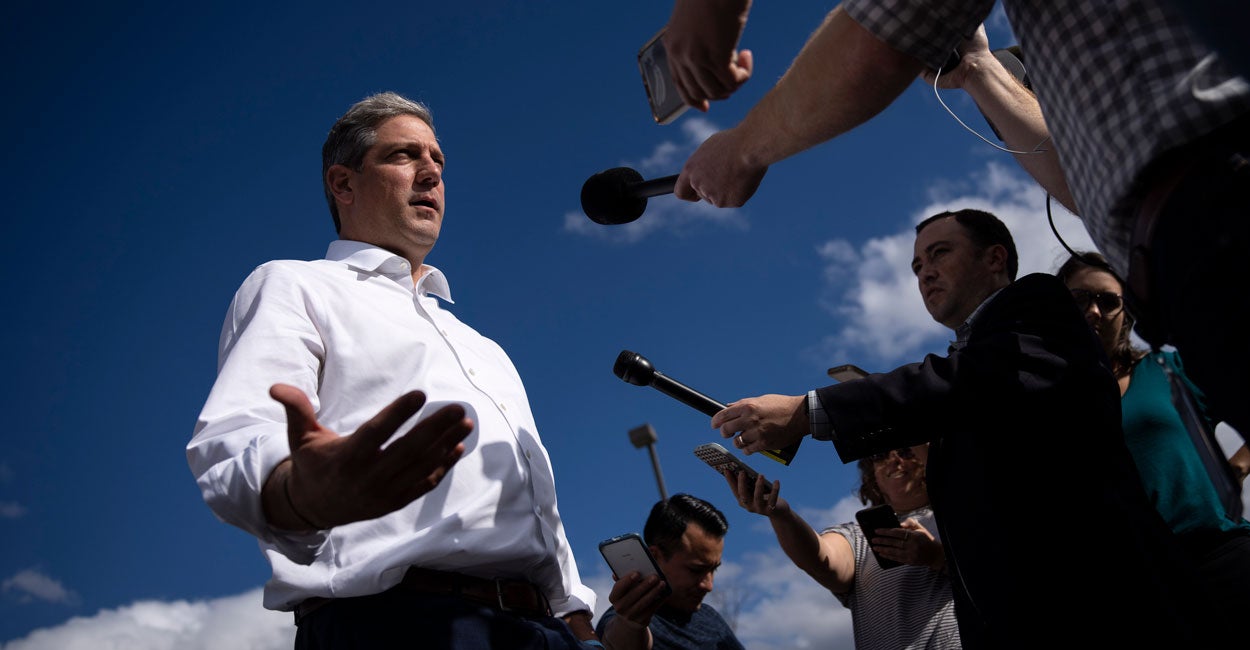
www.dailysignal.com
Tim Ryan Makes Major Announcement in Ohio Governor’s Race
After months of speculation as to what former Rep. Tim Ryan, D-Ohio, would do ahead of the 2026 elections, we now have our answer: Ryan will not be running for governor of the Buckeye State.
“After careful consideration, much prayer and reflection, and after long conversations with my family, my closest friends and advisors, I’ve made the decision not to run for governor in 2026,” Ryan said in a statement.
Rumors have been swirling for months about Ryan’s political plans, especially since a fellow Ohio Democrat, former Sen. Sherrod Brown, announced he was running for U.S. Senate. Brown lost last November to now Republican Sen. Bernie Moreno and is running to challenge Sen. Jon Husted, R-Ohio, who was appointed by Gov. Mike DeWine to fill Vice President JD Vance’s seat.
Vance had that Senate seat because he defeated Ryan in Ohio’s U.S. Senate race in 2022. Ryan previously served as a congressman for Ohio’s 13th Congressional District.
Ryan’s announcement is surely a boon to Dr. Amy Acton’s campaign. She is still the sole Democrat facing Republican businessman Vivek Ramaswamy in the upcoming gubernatorial election, and with Ryan opting out, likely avoids an expensive and difficult primary challenge.
A statement from Acton shared with The Daily Signal focused not on Ryan, but on putting her energy into going up against Ramaswamy.
“No matter what corner of the state I’m in, it’s clear Ohioans are struggling with rising costs. Whether it’s healthcare, childcare, gas or groceries, there’s too much money going out and not enough coming in. And while the special interests that run our state are doing just fine, they’ve made a mess for the rest of us, and I will not allow a billionaire Washington insider like Vivek Ramaswamy take us down an even worse path,” Acton said. “I’m running for Governor because it’s time for a change. Together, we can lower costs, give Ohioans a little breathing room, and build the Ohio we all deserve.”
Acton also released a video over social media on Friday morning, the same day news spread of Ryan’s decision. The nearly two-minute video also focused on costs.
Everywhere I go, Ohioans are stretched too thin — from energy bills, to healthcare costs, to property taxes and groceries. Costs keep rising while special interests call the shots. Enough is enough. I’m running for Governor so we can lower costs, give families some breathing… pic.twitter.com/dxFKmyIeHt— Dr. Amy Acton (@amyactonoh) November 21, 2025
A statement from Connie Luck, a spokesperson for the Ramaswamy campaign, focused on support from fellow Republicans for the campaign, and how Ramaswamy has used that to his advantage.
“While the Democrats have spent months fighting to secure their shrinking base, Vivek has been talking to voters of all political persuasions to build an unprecedented coalition of support that includes conservative leaders and farmers to truckers and labor unions—and we’re just getting started,” Luck told The Daily Signal.
Other Ohio Republicans have been quite vocal over X, including Ohio Republican Party Chairman Alex Triantafilou. In a statement that pointed out Ryan’s decision not to run should “come as no surprise to Ohioans,” Triantafilou focused on support for Ramaswamy as he goes up against Acton, calling the choice “obvious” to support Ramaswamy for next year.
pic.twitter.com/pp1MM3qPLR— Alex Triantafilou (@ChairmanAlex) November 21, 2025
Secretary of State Frank LaRose and state Sen. Rob McColley, president of the Ohio Senate, also weighed in on Ryan’s decision to opt out.
Like Triantafilou, LaRose and McColley stressed the unity and momentum around Ramaswamy, which has long been a focus from the Ramaswamy campaign as well as from the Ohio Republican Party.
Tim Ryan’s decision not to run for governor reinforces what we already know — that @VivekGRamaswamy is a unifying, visionary leader who’s building not just a political campaign but an unstoppable movement to lead Ohio into the future. We’ve never seen a candidate for governor put…— Frank LaRose (@FrankLaRose) November 21, 2025
McColley also focused on the support from various groups that Ramaswamy has received. Speaking of how a Democrat’s “path to victory is a difficult one” in this gubernatorial race, McColley called the news about Ryan “a reflection of that.”
.@VivekGRamaswamy’s remarkable unification of the Republican Party, record fundraising, and his broad coalition of support (including from labor groups) make any opponent’s path to victory a difficult one. Today’s news regarding Tim Ryan is a reflection of that.— Senator Rob McColley (@Rob_McColley) November 21, 2025
The race is regarded as “Likely Republican,” with Ramaswamy leading in most polls against Acton, including an Emerson College poll from August with a +10 lead. Acton has highlighted polls showing her with a narrow lead, however.
The post Tim Ryan Makes Major Announcement in Ohio Governor’s Race appeared first on The Daily Signal.













